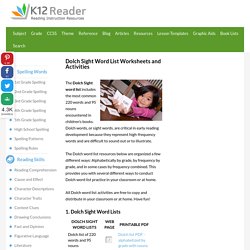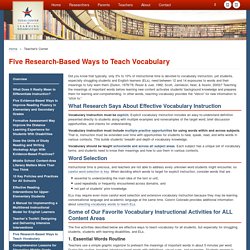

Dolch Word List Resources. The Dolch Sight word list includes the most common 220 words and 95 nouns encountered in children’s books.

Dolch words, or sight words, are critical in early reading development because they represent high-frequency words and are difficult to sound out or to illustrate. The Dolch word list resources below are organized a few different ways: Alphabetically by grade, by frequency by grade, and in some cases by frequency combined. This provides you with several different ways to conduct Dolch word list practice in your classroom or at home. All Dolch word list activities are free to copy and distribute in your classroom or at home. Have fun! 1. 2. Click on the link below to access twenty free Dolch word list word search puzzles and answer keys.
Twenty Free Word Search Worksheets 3. Each set of flash cards are displayed 8 to a page and ready to print. 4. Cloze worksheets below are divided into grade levels with three worksheets per grade plus nouns. Five Research-Based Ways to Teach Vocabulary. Did you know that typically, only 5% to 10% of instructional time is devoted to vocabulary instruction, yet students, especially struggling students and English learners (ELs), need between 12 and 14 exposures to words and their meanings to fully learn them (Durkin, 1978/79; Roser & Juel, 1982; Scott, Jamieson, Noel, & Asslin, 2003)?

Teaching the meanings of important words before learning new content activates students' background knowledge and prepares them for learning and comprehending. In other words, teaching vocabulary provides the “Velcro” for new information to “stick to.” What Research Says About Effective Vocabulary Instruction Vocabulary instruction must be explicit. Explicit vocabulary instruction includes an easy-to-understand definition presented directly to students along with multiple examples and nonexamples of the target word, brief discussion opportunities, and checks for understanding.
Vocabulary should be taught schoolwide and across all subject areas. Connecting Word Meanings Through Semantic Mapping. Semantic maps (or graphic organizers) are maps or webs of words.

The purpose of creating a map is to visually display the meaning-based connections between a word or phrase and a set of related words or concepts. Semantic maps help students, especially struggling students and those with disabilities, to identify, understand, and recall the meaning of words they read in the text. Learning to create these maps aligns with three of the ELA Common Core State Standards: Teaching students to use semantic maps You can provide your students with direct instruction on how to use semantic maps. Pick a word you don’t know from a text you are reading and mark the word. With direct instruction and repeated practice, struggling students will find that using semantic maps is a very good way of expanding their vocabulary. Integrating technology There are many technology tools that can help students create semantic maps (including thinking maps, mind maps, bubble maps, and concept maps).
Mr. Mr. Word Analysis to Expand Vocabulary Development. Introduction When students engage in "word analysis" or "word study," they break words down into their smallest units of meaning — morphemes.

Each morpheme has a meaning that contributes to our understanding of the whole word. As such, students’ knowledge of morphemes helps them to identify the meaning of words and build their vocabulary. The Institute for Educational Science (IES) Practice Guide strongly recommends providing explicit vocabulary instruction, which includes providing students with strategies for acquiring new vocabulary. The ability to analyze words is a critical foundational reading skill and is essential for vocabulary development as students become college and career ready. Teaching word analysis skills satisfies several of the Common Core State Standards for literacy, including: Five Research-Based Ways to Teach Vocabulary. Frayer Model. 7 Ways to Teach Word Analysis Every Day - Alyssa Teaches.
One of my favorite fourth grade language arts units to teach is word analysis.

Why? Because word analysis skills help kids become stronger independent readers. I love showing students that they can go from relying on other people to learn what a word in a book means to being able to figure it out themselves! They become more confident readers as they learn different strategies to tackle new words. You probably already know that vocabulary knowledge is an essential part of reading comprehension. It’s All About That Spiral The approach that has worked best for me is to spiral, spiral, spiral. This means TONS of reading, exposure to unfamiliar words, direct instruction of vocabulary words, and revisiting all those word solving skills daily. What Are Word Analysis Skills? Okay, before I go much further – word analysis is basically word study. The goal is to help students learn the skills to decipher unknown words as they read independently. Get Kids Reading Okay, this one is obvious. Read Aloud.